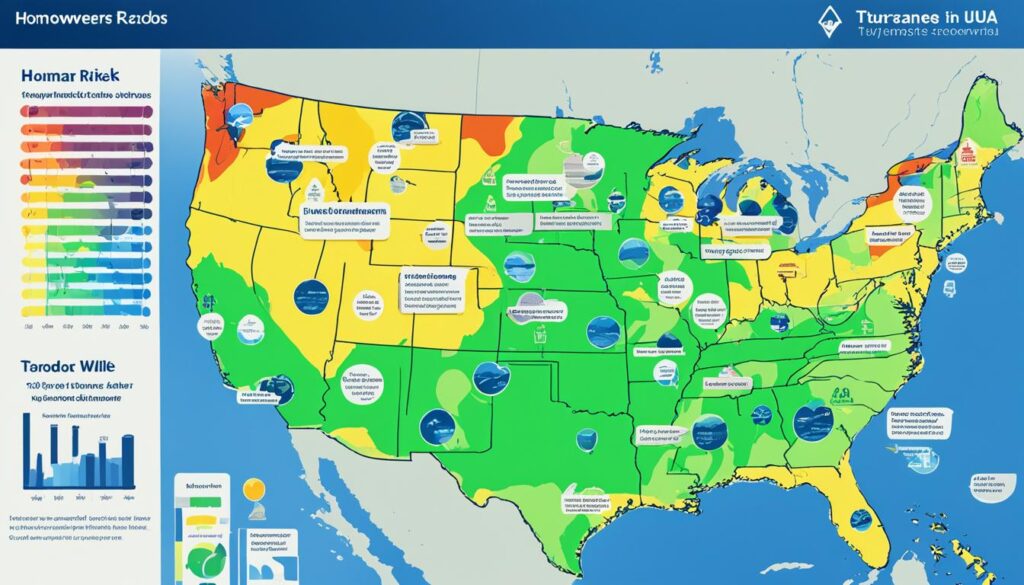Home insurance is essential for protecting one of your most significant investments—your home. In the USA, various options for homeowners insurance exist, allowing thousands of homeowners to seek affordable and comprehensive protection. Securing reliable coverage not only ensures financial stability but also provides peace of mind against unexpected events like natural disasters or theft.
As the importance of property insurance grows, understanding its role in asset protection becomes vital. To discover more about how to navigate the complexities of homeowners insurance in California, check out this informative guide: Homeowners Insurance in California.
Key Takeaways
- Home insurance protects your home and personal belongings against various risks.
- Understanding local risks helps tailor your homeowners insurance coverage.
- Comparing multiple quotes ensures finding the best rates available.
- Different policies offer unique coverage options and limits for homeowners.
- Being aware of additional endorsements can enhance the protection of your property.
- Ultimately, having adequate home insurance secures both your financial investment and peace of mind.
Unlock Investment Opportunities Abroad!
Understanding the Importance of Home Insurance
Homeowners insurance, known as home insurance in the USA, serves as a vital shield against potential losses from risks that can affect one’s residence. It offers a comprehensive safety net covering varied aspects such as damage, theft, and liability. This financial protection is essential for safeguarding not just the physical structure but also personal belongings.
What is Home Insurance?
Home insurance is a policy designed to protect residential property against certain risks. Most mortgage lenders in the USA require homeowners coverage to secure their investments, as homes often represent the largest asset for consumers. Coverage types include Dwelling, Other Structures, Personal Property, Loss of Use and more, ensuring a broad range of protections for various circumstances1.
The Role of Home Insurance in Asset Protection
The role of home insurance in asset protection is profound, as it mitigates the financial impact of unforeseen disasters. For instance, replacement cost policies allow for the full reimbursement of damaged or destroyed property without depreciation adjustments, which is crucial for maintaining financial stability2. Homeowner policies typically include coverage against perils such as fire, theft, and vandalism, emphasizing their importance in safeguarding investments1.
Risk Factors Leading to Home Insurance Needs
Numerous risk factors can heighten the necessity of obtaining homeowners insurance. Factors such as the geographic region’s vulnerability to natural disasters—like hurricanes or wildfires—play a significant role in determining coverage needs. Additionally, liability claims stemming from accidents on the property represent a critical reason for maintaining a robust homeowners insurance policy3. Understanding these risks can empower homeowners in making informed decisions regarding their asset protection strategies.
Home Insurance the USA: Key Considerations

When evaluating home insurance, several key factors play a pivotal role. Homeowners must pay close attention to local climate risks as these directly influence the necessity for insurance coverage. For instance, homes situated in areas prone to storms may require specific policies to address unique needs.
Local Climate Risks and Their Implications
Local climate risks significantly impact the type of insurance coverage homeowners need. In regions like Florida, severe weather patterns create a demand for policies that include windstorm and flood insurance. Failure to address these local climate risks can leave homeowners underinsured and vulnerable to substantial financial losses.
State-Specific Insurance Regulations
State regulations dictate the structure and nature of home insurance policies available to homeowners. This can mean variations in coverage requirements and options, as each state has unique guidelines that affect what insurance is mandatory and which additional coverages might be beneficial. Understanding your state’s regulations is crucial for selecting optimal coverage that meets local standards.
Homeowners’ Perception of Insurance Necessity
The perception of home insurance necessity is evolving among homeowners. Increasing concerns about affordability have led to a rise in uninsured homes, from 5% to 12%, particularly impacting lower-income households. This shift prompts homeowners to reassess their needs and the importance of securing adequate coverage against local climate risks and specific state regulations. Homeowners are encouraged to explore options that enhance their understanding of the home insurance necessity, especially in light of increasing costs. More information on coverage considerations is available through resources such as this article4.
Finding the Best Home Insurance Rates

Finding the best home insurance rates can significantly impact your overall expenses. Understanding factors affecting premiums is crucial in this quest. Various aspects like home location, property value, and history of claims play a substantial role.
Factors Affecting Home Insurance Premiums
Several elements contribute to setting home insurance premiums. For instance, geographic location renders specific risks like flooding or wildfires. The average annual premium for homeowners insurance in the U.S. stands at $2,728, based on extensive data analysis that included 5 million estimates gathered across all 50 states5. Home value influences the rates directly, with higher valued homes commanding higher premiums. Personal factors such as credit score and claim history may also drastically shift your rates.
How to Compare Home Insurance Quotes
To secure the best home insurance rates, it’s wise to compare home insurance quotes from multiple providers. Platforms like Bankrate and HomeInsurance.com enable consumers to score personalized quotes. By answering a few straightforward questions, homeowners can easily access a range of competitive rate offers from recognized carriers6. Reviewing quotes from at least three different companies allows for a comprehensive understanding of coverage options and pricing. Furthermore, companies like NerdWallet have meticulously analyzed rates from over 272 million data points and 815 insurers, enhancing your ability to make informed decisions7.
Strategies for Securing Affordable Homeowners Insurance
Adopting smart strategies can help lower your home insurance costs. Implementing improved security measures can significantly affect premiums positively. Insurance providers often offer discounts for bundling multiple policies, such as home and auto, further contributing to more affordable homeowners insurance. Taking time to shop around for rates and understand various coverage options can help in finding not just the best rates but valuable benefits that suit your needs.
| Coverage Type | Average Annual Premium |
|---|---|
| New Homeowners | $2,200 |
| Standard Coverage | $2,673 |
| Extended Coverage | $2,027 |
| Military Members | $2,029 |
| Best Value Coverage | $2,138 |
| Customizable Coverage | $3,238 |
Top Home Insurance Companies in the USA

When it comes to securing your property, selecting from the top home insurance companies is critical. These industry leaders not only provide various coverage options but also boast significant market shares and customer satisfaction ratings. Understanding their unique offerings can help homeowners make informed decisions.
Unlock Investment Opportunities Abroad!
Industry Leaders and Their Unique Offerings
State Farm, Allstate, and Liberty Mutual are the largest home insurers in the United States, commanding market shares of 17.79%, 8.92%, and 6.89%, respectively. As a leader in the market, State Farm has direct written premiums of $25.7 billion, with an average annual premium of $1,854 for $300,000 in dwelling coverage. Their customer satisfaction score stands at 829 out of 1,000, reflecting their commitment to quality service8.
Allstate, capturing a substantial $12.7 billion in direct premiums, charges an average of $1,959 annually for similar coverage, achieving a customer satisfaction score of 809. Liberty Mutual also plays a vital role in the market, with $10.1 billion in direct premiums but lacks specified average cost data while maintaining a score of 7898.
USAA is known for its appealing offerings to veterans, with a competitive average premium of $1,452 and an impressive customer satisfaction score of 8818. Farmers Insurance follows closely with a market share of 5.91%, offering substantial coverage at an average premium of $2,500, rated at 800 in customer satisfaction8.
Customer Satisfaction Ratings and Reviews
When evaluating home insurance, customer satisfaction ratings are paramount in determining service quality. USAA leads the pack with a satisfaction score of 881, while Erie excels in property claims satisfaction, scoring 912 out of 1,000 in the respective study9. This indicates that both of these insurers provide exceptional experiences for their policyholders, resulting in high loyalty rates.
In addition, State Farm’s bundling options—offering discounts of up to 23% for home and auto insurance—make it a favored choice for many homeowners seeking comprehensive coverage9.
Comparative Analysis of Coverage and Prices
For homeowners, conducting an insurance coverage analysis is crucial in selecting the right provider. Companies like Westfield offer the best entry point for insurance with an average rate of $1,344 for policies covering $350,000 in dwelling value, focusing on affordable options9.
Other notable mentions include Auto-Owners, recognized for providing attractive discount options with an annual rate of only $729 for the same coverage. Chubb also caters to high-net-worth individuals with premium services and flexible deductible structures for significant savings9.
| Insurance Company | Market Share (%) | Direct Premiums Written ($ Billion) | Average Annual Premium ($) | Customer Satisfaction Score (out of 1000) |
|---|---|---|---|---|
| State Farm | 17.79 | 25.7 | 1854 | 829 |
| Allstate | 8.92 | 12.7 | 1959 | 809 |
| Liberty Mutual | 6.89 | 10.1 | N/A | 789 |
| USAA | 6.81 | 9.5 | 1452 | 881 |
| Farmers Insurance | 5.91 | 8.5 | 2500 | 800 |
Evaluating these specifications allows homeowners to make astute choices regarding their insurance policies, balancing cost against the level of service and coverage provided by these top home insurance companies.
Understanding Home Insurance Policies
Your home is likely one of your most significant investments, making it crucial to comprehend the various types of home insurance policies available. Understanding these policies—such as HO-1, HO-2, and the widely-adopted HO-3—is essential for homeowners to select adequate coverage. The typical HO-3 policy protects against 16 different perils, including fire, theft, and vandalism, while also providing coverage for your dwelling, personal belongings, liability, and loss of use1011.
Types of Home Insurance Policies Available
Homeowners can choose from several policies tailored to their unique needs. The HO-1 is a basic policy with limited coverage, whereas the HO-2 provides more comprehensive protection for a wider array of risks. The most commonly used policy, HO-3, typically covers dwelling and personal property at replacement cost, meaning you won’t suffer financial loss due to depreciation1211.
Essential Coverage Areas Explained
It’s important to evaluate the essential coverage areas in your policy. This includes protections for your dwelling, which usually safeguards 50 to 70 percent of the structure’s value, alongside personal property coverage which applies to items stolen or damaged due to specific disasters1211. Liability coverage offers legal protection and other helpful features, such as no-fault medical coverage for injuries occurring in your home10.
Additional Coverage Options to Consider
When reviewing home insurance policies, consider additional coverage options that may apply to your situation. Depending on your location, obtaining coverage for natural disasters such as floods or earthquakes might be wise, as standard policies often exclude these events12. Many homeowners also invest in additional living expense coverage, which compensates for costs related to hotel stays and meals when their home is uninhabitable due to damage1011. For more detailed insights, visit this home insurance guide.
Unlock Investment Opportunities Abroad!
FAQ
What is home insurance, and why do I need it?
How can I find the best home insurance rates?
What factors affect home insurance premiums?
Are there specific home insurance policies for different types of homes?
What additional coverage options should I consider?
How can I save on homeowners insurance?
What are some top home insurance companies in the USA?
Source Links
- https://content.naic.org/insurance-topics/homeowners-insurance
- http://www.rmiia.org/homeowners/Walking_Through_Your_Policy/Homeowners_Insurance_basics.asp
- https://www.mass.gov/info-details/understanding-home-insurance
- https://www.usnews.com/insurance/homeowners-insurance/what-does-homeowners-insurance-cover
- https://www.marketwatch.com/guides/insurance-services/best-homeowners-insurance-companies/
- https://www.bankrate.com/insurance/homeowners-insurance/home-insurance-quotes/
- https://www.nerdwallet.com/a/insurance/best-homeowners-insurance
- https://www.bankrate.com/insurance/homeowners-insurance/largest-home-insurance-companies/
- https://www.usatoday.com/money/blueprint/home-insurance/best-homeowners-insurance-companies/
- https://www.bankrate.com/insurance/homeowners-insurance/how-to-read-a-home-insurance-policy/
- https://www.iii.org/article/homeowners-insurance-basics
- https://doi.sc.gov/963/Understanding-Basic-Homeowners-Insurance

Comments